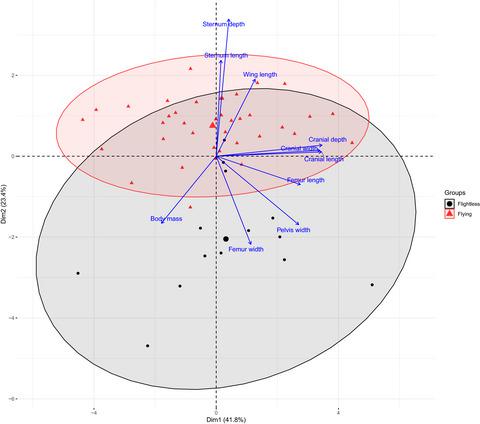当前位置:
X-MOL 学术
›
Ecol. Evol.
›
论文详情
Our official English website, www.x-mol.net, welcomes your
feedback! (Note: you will need to create a separate account there.)
Convergent morphological responses to loss of flight in rails (Aves: Rallidae).
Ecology and Evolution ( IF 2.3 ) Pub Date : 2020-06-01 , DOI: 10.1002/ece3.6298 Julien Gaspar 1 , Gillian C Gibb 1 , Steve A Trewick 1
Ecology and Evolution ( IF 2.3 ) Pub Date : 2020-06-01 , DOI: 10.1002/ece3.6298 Julien Gaspar 1 , Gillian C Gibb 1 , Steve A Trewick 1
Affiliation

|
The physiological demands of flight exert strong selection pressure on avian morphology and so it is to be expected that the evolutionary loss of flight capacity would involve profound changes in traits. Here, we investigate morphological consequences of flightlessness in a bird family where the condition has evolved repeatedly. The Rallidae include more than 130 recognized species of which over 30 are flightless. Morphological and molecular phylogenetic data were used here to compare species with and without the ability to fly in order to determine major phenotypic effects of the transition from flighted to flightless. We find statistical support for similar morphological response among unrelated flightless lineages, characterized by a shift in energy allocation from the forelimbs to the hindlimbs. Indeed, flightless birds exhibit smaller sterna and wings than flighted taxa in the same family along with wider pelves and more robust femora. Phylogenetic signal tests demonstrate that those differences are independent of phylogeny and instead demonstrate convergent morphological adaptation associated with a walking ecology. We found too that morphological variation was greater among flightless rails than flighted ones, suggesting that relaxation of physiological demands during the transition to flightlessness frees morphological traits to evolve in response to more varied ecological opportunities.
中文翻译:

对轨道飞行损失的趋同形态反应(鸟纲:Rallidae)。
飞行的生理需求对鸟类形态施加了强大的选择压力,因此预计飞行能力的进化丧失将涉及性状的深刻变化。在这里,我们研究了无法飞行的鸟类家族的形态学后果,因为这种情况已经反复演变。鸡科动物包括 130 多种公认的物种,其中 30 多种是不会飞的。这里使用形态学和分子系统发育数据来比较具有和不具有飞行能力的物种,以确定从会飞到不会飞的转变的主要表型效应。我们发现统计支持在不相关的不会飞的谱系中存在类似的形态反应,其特征是能量分配从前肢到后肢的转变。事实上,不会飞的鸟类比同一科中会飞的类群表现出更小的胸骨和翅膀,以及更宽的骨盆和更坚固的股骨。系统发育信号测试表明,这些差异与系统发育无关,而是证明了与步行生态学相关的趋同形态适应。我们还发现,不会飞行的铁轨的形态变异比有飞行的铁轨更大,这表明在向不会飞行的过渡过程中生理需求的放松可以释放形态特征,以适应更多样化的生态机会。
更新日期:2020-07-25
中文翻译:

对轨道飞行损失的趋同形态反应(鸟纲:Rallidae)。
飞行的生理需求对鸟类形态施加了强大的选择压力,因此预计飞行能力的进化丧失将涉及性状的深刻变化。在这里,我们研究了无法飞行的鸟类家族的形态学后果,因为这种情况已经反复演变。鸡科动物包括 130 多种公认的物种,其中 30 多种是不会飞的。这里使用形态学和分子系统发育数据来比较具有和不具有飞行能力的物种,以确定从会飞到不会飞的转变的主要表型效应。我们发现统计支持在不相关的不会飞的谱系中存在类似的形态反应,其特征是能量分配从前肢到后肢的转变。事实上,不会飞的鸟类比同一科中会飞的类群表现出更小的胸骨和翅膀,以及更宽的骨盆和更坚固的股骨。系统发育信号测试表明,这些差异与系统发育无关,而是证明了与步行生态学相关的趋同形态适应。我们还发现,不会飞行的铁轨的形态变异比有飞行的铁轨更大,这表明在向不会飞行的过渡过程中生理需求的放松可以释放形态特征,以适应更多样化的生态机会。











































 京公网安备 11010802027423号
京公网安备 11010802027423号